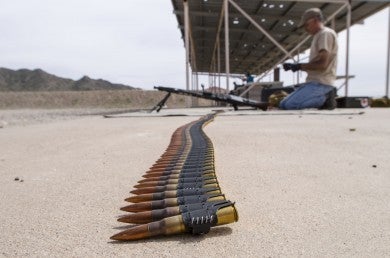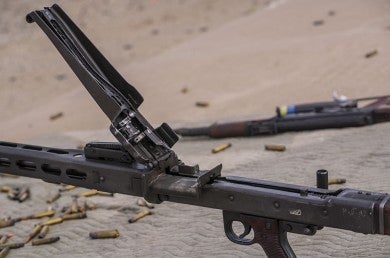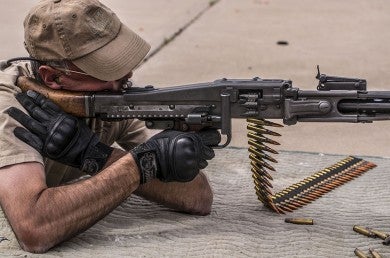A Brief Look at the MG42
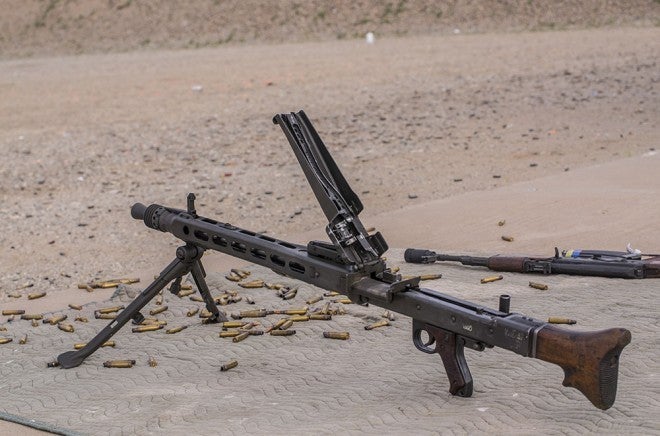
As firearms go, few have been as influential – and yet seldom seen by the general public – as the MG42 machine gun. While the 1911 pistol and the Mauser bolt action rifle influenced countless other firearms, they or their descendants are ubiquitous. The MG42 and its assorted descendants? Other than those who served in combat arms units of major Western militaries, not many people get a chance to see what a general purpose machine gun (GPMG) is like.
So when I had the chance to not only poke one, but shoot it, I was truly excited to go to the range. I probably hadn’t been that excited since the last time I shot my Marlin Papoose, which was actually the week before, but I digress. This particular MG42 is a non-transferable post sample machine gun property of Piece of History Firearms, a Class 2 SOT, or federally licensed manufacturer of machine guns. Now – on to the weapon itself.
VIDEO
The MG42 was the standard GPMG of the Wehrmacht – the German Army – during World War II. While many things went wrong in that country during that time, one thing the Germans (unfortunately?) got very right was the MG42. Firing belts of 8x57mm at a rate of over 1200 rounds per minute, the weapon acquired a fearsome reputation due in part to the sound it made during firing. A byproduct of that high rate of fire is that individual shots are nearly impossible to pick out. It simply sounds like a ripping, tearing saw, earning it nicknames such as “buzzsaw.”
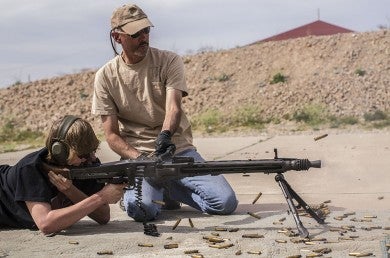
My girlfriend’s little brother had never fired a gun before. Needless to say, he had a good time (under the supervision of Mario from Piece of History Firearms, seen here, and myself).
I had previous experience with the FN M240G from my time in the military. As the 240 is derived from the FN MAG which derives some elements of design from the MG42, it wasn’t terribly difficult to adapt to the older machine gun. There are minor differences in materials and major differences in design – it’s not as if parts will swap between the two – but loading and firing procedures were remarkably similar.
A latch at the rear of the top cover/feed tray cover allows it to rotate up, exposing the feed tray as well as the feed lever inside the top cover. With the bolt forward, a fresh belt is put in place, then the top cover closed. The bolt is pulled to the rear with the charging handle, which is then pushed to the forward position. Push the safety off, and the weapon is ready to fire.
We had a few hiccups at first, in part because it had been a while for both of us, and in part because the weapon was pretty dry. A decent amount of FP-10 from my range bag went onto the bolt, and then, other than a few malfunctions due to pressure on the belt, the “buzzsaw” lived up to its name.
Naturally, with no staff NCOs around to berate me, one of my first inclinations after familiarizing myself with the weapon was to attempt to fire it from the standing position. To my surprise, it was actually fairly easy to control from both “the hip” and the shoulder while standing. Now, it’s important to understand that control is relative. All of my rounds impacted the berm or the ground in front of the berm. However, I cannot guarantee that I would have been able to hit a point target past, say, 10 yards.
As you can see in the video, it was a bit demanding – the weapon weighs about 25lbs with bipod, and I was already a bit dehydrated when I hit the range. Still, it was really a lot of fun to shoot, and now I can say that I’ve fired a belt fed machine gun from the hip while wearing flip flops and Ray Bans.
Hopefully, you’ve enjoyed this little look at one of the 20th century’s most infamous firearms. Thanks for reading!
